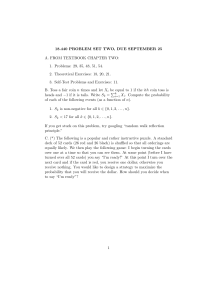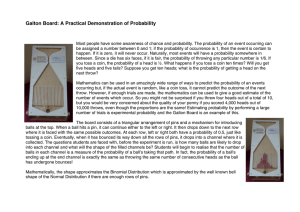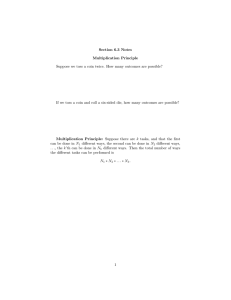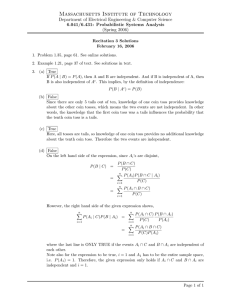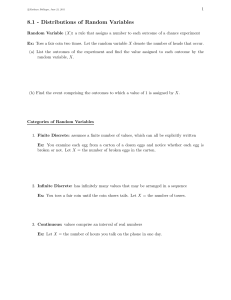Document 13626377
advertisement
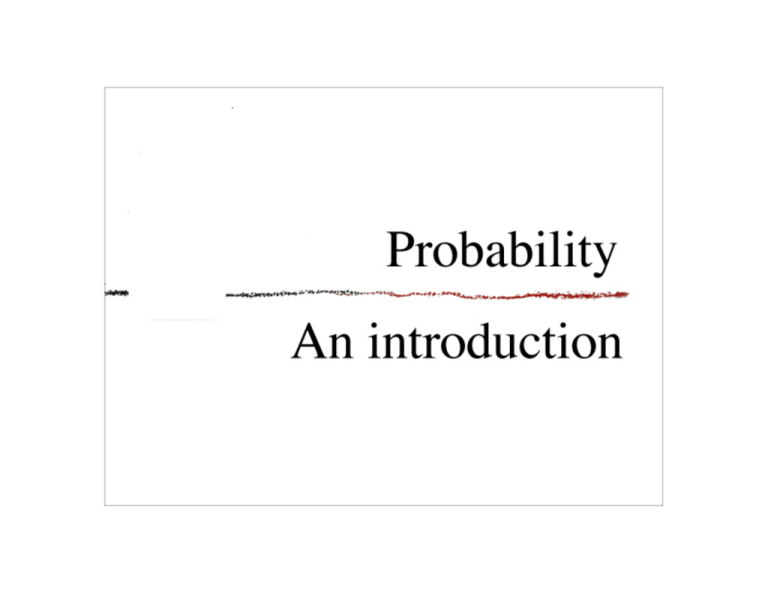
Probability theory presents a systematic way to think about such issues Examples Probability of: A newborn will be male? Getting HH in a coin toss? Getting a particular face on a die? In a bag with 1 red, 1 green and 3 blue balls. What is the probability to draw a red ball, a red or a blue ball? Compound Probabilities Disjunctive probabilities linked by addition A or B Conjunctive probability A and B Disjunctive In a bag with 1 red, 1 green and 3 blue balls. What is the likelihood that you draw a red or a green ball? In a bag with 1 red, 1 green and 3 blue balls. What is the likelihood that you draw a red or a blue ball? Conjunctive I In 2 coin tosses, what’s the likelihood of getting 2 heads? T T T H H T H H Conjunctive II In a bag with 1 red, 1 green and 3 blue balls. What is the likelihood that in 2 drawings you get 2 red balls? In a bag with 1 red, 1 green and 3 blue balls. What is the likelihood that 2 drawings you get 1 red and 1 blue ball? Probability pathway Head (0.5) Tail (0.5) Tail (0.5) Head (0.5) (0.25) H&T (0.5) (0.25) Frequency of 2 coin toss 1.0 .8 .5 .3 0 0H/2T 1H/1T 2H/0T Frequency of 3 coin toss 1.0 .8 .5 .3 0 0H/3T 1H/2T 2H/1T 3H/0T Frequency of 6 coin toss .50 .38 How? .25 .13 Is it sig? 0 0H/6T 1H/5T 2H/4T 3H/3T 4H/2T 5H/1T 6H/0T Binomial Distribution I • A dramatic disease causes death in 60% of the cases. Only 40% people survive. • What is the likelihood that 10 out of 10 people survive? • • Only one possible way to get 10 / 10… • .4 * .4 * .4 * .4 * .4 * .4 * .4 * .4 * .4 * .4 =.0001 Binomial Distribution II • A dramatic disease causes death in 60% of the cases. Only 40% people survive. • What is the likelihood that (at least) 7 out of 10 people survive? • A bit more complex ... Calculating bonomial probabilities P(r out of n) = number of possible ways X Probability of each way Number of possible ways = n!/[r!(n-r)!] P(7 out of 10) = 0.4^(r) x 0.6^(n-r) = 0.4^7 x 0.6^3 = 0.00035389 10!/7!3!=120 P(7 out of 10) = 0.0425 7 or more out of 10? 7 out of 10 + 8 out of 10 + 9 out of 10 + 10 out of 10 When we calculate the probability of an outcome (7), most times we calculate the probaility of the outcome or a more extreme outcome Binomial summary By using the binomial distribution we can directly calculate the probability of en event (or a more extreme event). We can compare this probability to 0.05 and decide if it is significant or not. Calculating distributions: 6 coins tossed: n = 6; p = .5; q = .5 Theoretical mean (m) = np = 6 * .5 = 3 central tendency of distribution Variance (s^2) = n *p*q Standard deviation = s z = (r-m) / s Z scores z = (r-m) / s Probability of 6 Heads: z = (6-3) / 1.225 = 2.45 Look for z = 2.45 in the Normal distribution table Central limit theorem Approximations of normal distributions with increased number of observations Frequency of 6 coin toss (10) 10 8 6 4 2 0 0H/6T 1H/5T 2H/4T 3H/3T 4H/2T 5H/1T 6H/0T Frequency of 6 coin toss (100) 40 32 24 16 8 0 0H/6T 1H/5T 2H/4T 3H/3T 4H/2T 5H/1T 6H/0T Frequency of 6 coin toss (1,000) 400 350 300 250 200 150 100 50 0 0H/6T 1H/5T 2H/4T 3H/3T 4H/2T 5H/1T 6H/0T Summary Probability This is the base of stattistics... Binomial: A way to calculate probabilities of events directly Central limit theorem

